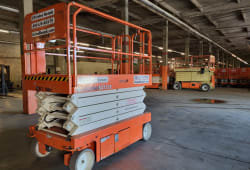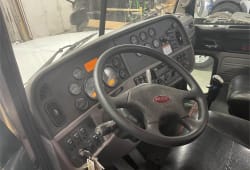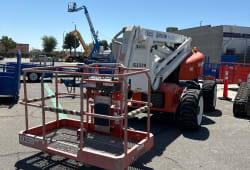Exploring Export Opportunities: Used Heavy Equipment Regulations
12 Lectura mínima
)
agosto 11, 2023
In today's global market, exporting used heavy equipment can present lucrative opportunities for businesses. However, navigating the regulations surrounding this industry can be a daunting task. This article aims to shed light on the global demand for used heavy equipment, the various export regulations that need to be considered, the impact of these regulations on export opportunities, successful case studies, and future trends in the industry.
Understanding the Global Demand for Used Heavy Equipment
The demand for used heavy equipment is on the rise across the world. Many countries, particularly those in developing regions, find it more cost-effective to purchase used equipment rather than invest in new machinery. Used heavy equipment allows businesses to acquire necessary assets at a lower price point, enabling them to allocate their resources efficiently.
Key markets for used heavy equipment include emerging economies such as India, China, and Brazil, where infrastructure development is rapidly growing. These markets present significant opportunities for exporters, as they strive to meet the increasing demand for construction and infrastructure projects.
Several factors drive the demand for used heavy equipment. First and foremost, cost plays a crucial role. Used equipment can be purchased at a fraction of the cost of new machinery, making it an attractive option for businesses operating on limited budgets. Additionally, the availability of spare parts and established service networks also contribute to the demand, as it ensures the longevity and reliability of the used machinery.
Furthermore, the demand for used heavy equipment is influenced by the environmental impact of manufacturing new machinery. As the world becomes more conscious of the need for sustainable practices, businesses are increasingly opting for used equipment to reduce their carbon footprint. By extending the lifespan of heavy machinery through reuse, companies can minimize the environmental impact associated with manufacturing new equipment.
Moreover, the availability of a wide range of used heavy equipment in the market enhances the demand. From excavators and bulldozers to cranes and loaders, businesses have access to a diverse selection of machinery that meets their specific needs. This variety allows companies to find the right equipment for their projects, ensuring optimal performance and productivity.
Additionally, the advancements in technology have contributed to the growing demand for used heavy equipment. As newer models with advanced features and capabilities are introduced, businesses often upgrade their existing machinery. This leads to a surplus of used equipment in the market, creating opportunities for buyers to acquire high-quality machinery at a lower cost.
Furthermore, the global trend of outsourcing construction projects has also fueled the demand for used heavy equipment. Many companies in developed countries prefer to outsource construction projects to countries with lower labor costs, such as India and China. Consequently, this has increased the demand for used machinery in these countries, as they require reliable and efficient equipment to complete these projects.
Lastly, the economic benefits of purchasing used heavy equipment cannot be overlooked. By investing in used machinery, businesses can allocate their resources more effectively, allowing them to invest in other areas of their operations. This flexibility enables companies to expand their capabilities, take on more projects, and ultimately, increase their profitability.
Navigating the Export Regulations for Used Heavy Equipment
Exporting used heavy equipment involves complying with various regulations to ensure smooth and legal operations. While each country has its own set of general export regulations, specific guidelines for used heavy equipment must also be adhered to.
General export regulations typically encompass aspects such as obtaining relevant permits and licenses, complying with customs requirements, and ensuring compliance with international trade agreements. Exporters must familiarize themselves with these regulations and fulfill all necessary obligations to ensure legality and smooth operations.
When it comes to exporting used heavy equipment, there are additional considerations that need to be taken into account. These considerations revolve around inspections, certifications, and adherence to environmental standards.
Inspections play a crucial role in the export process. Before exporting the heavy equipment, it may be required to undergo a thorough inspection to ensure it meets the safety and quality standards of the destination country. This inspection may include checking the equipment's functionality, structural integrity, and compliance with specific technical requirements.
Certifications also play a significant role in the export of used heavy equipment. Depending on the destination country, exporters may need to obtain certifications that validate the equipment's compliance with local regulations. These certifications may include proof of emissions compliance, safety standards, and other relevant certifications specific to the equipment being exported.
Another important aspect to consider is adherence to environmental standards. Many countries have strict regulations in place to protect the environment and ensure sustainable practices. Exporters of used heavy equipment must ensure that the equipment being exported meets these environmental standards. This may involve providing documentation regarding the equipment's emissions levels, fuel efficiency, and any necessary measures taken to mitigate environmental impact.
Researching and understanding the specific regulations applicable in the destination country is crucial to avoid any potential delays, fines, or legal ramifications. It is recommended to consult with legal experts or trade consultants who specialize in export regulations for used heavy equipment. These professionals can provide valuable guidance and ensure compliance with all necessary regulations.
Impact of Regulations on Export Opportunities
Regulations play a significant role in shaping the export opportunities available to businesses in the used heavy equipment industry. While they may initially seem burdensome, regulations can create new avenues for growth and success. In this expanded version, we will explore the various ways in which regulations impact export opportunities, both positively and negatively.
Firstly, regulations establish a framework for fair competition by ensuring that all exporters meet the same standards. This is particularly important in industries like the used heavy equipment sector, where safety and quality are paramount. By setting minimum requirements for exporters, regulations help protect buyers from substandard products and unethical practices. This allows reputable businesses to distinguish themselves from unscrupulous ones, fostering trust and credibility in the market.
Moreover, compliance with regulations goes beyond mere legal obligations. It helps businesses establish long-term relationships with customers and establish a positive reputation in the industry. By consistently meeting regulatory requirements, exporters can build trust with buyers and position themselves as reliable partners in the global market. This can lead to repeat business and referrals, widening their export opportunities.
However, it is crucial to acknowledge that some challenges may arise due to regulations. Exporters may face higher initial costs for complying with regulatory standards. For instance, they may need to invest in specialized equipment or undergo extensive training to meet safety and environmental regulations. While these costs may pose a temporary burden, they ultimately contribute to the overall growth and sustainability of the industry.
Additionally, the varying regulations across different countries can complicate the export process. Each market may have its own set of rules and requirements, ranging from documentation and labeling to product certifications. Exporters must invest time and resources into thoroughly understanding and meeting these regulations to minimize disruptions and maximize opportunities. This can involve hiring legal experts or partnering with local distributors who have a deep understanding of the regulatory landscape.
Despite the challenges, it is important to view regulations as an opportunity rather than a hindrance. They provide a level playing field for exporters, ensuring fair competition and protecting the interests of buyers. By embracing regulations and incorporating them into their business strategies, exporters can enhance their reputation, build trust, and unlock new export opportunities.
In conclusion, regulations have a significant impact on export opportunities in the used heavy equipment industry. While they may impose certain challenges, they also create a framework for fair competition, foster trust, and establish long-term relationships with customers. By navigating the regulatory landscape effectively, exporters can position themselves as reliable partners and expand their presence in the global market.
Case Studies: Successful Export of Used Heavy Equipment
Examining successful export cases can provide insight into the best strategies and practices for navigating regulations in the used heavy equipment industry.
Exporting used heavy equipment can be a lucrative business opportunity, especially in developing countries where there is a growing demand for such equipment. However, navigating the complex regulations and requirements of different countries can be a daunting task. In this article, we will explore two case studies that highlight successful export strategies and how exporters overcame various challenges.
Case Study 1: Exporting to Developing Countries
In this case, an equipment exporter successfully tapped into the growing demand for used heavy equipment in developing countries. The exporter recognized the potential of these markets and conducted thorough market research to identify the most promising countries to target.
Understanding the specific regulations in each target country was crucial for the exporter to ensure compliance with import and safety standards. They invested time and resources in studying the local laws and regulations, including customs requirements and safety certifications. By doing so, they were able to navigate the often complex and ever-changing regulatory landscape.
Additionally, the exporter recognized the importance of building strong relationships with local distributors. They partnered with reputable distributors who had a deep understanding of the local market and established networks. This helped them overcome potential barriers related to language, culture, and logistics. By working closely with these distributors, the exporter was able to establish a strong presence in the target countries and gain the trust of local customers.
Customer support played a crucial role in their success as well. The exporter focused on providing exceptional after-sales service and support, ensuring that customers were satisfied with their purchases. This commitment to customer satisfaction helped them build long-term relationships and secure repeat business.
As a result of their strategic approach, the exporter achieved sustained growth and expanded their export opportunities. They became a trusted name in the industry, known for their high-quality products and reliable service.
Case Study 2: Overcoming Regulatory Challenges
In this case study, we will explore how an equipment exporter tackled regulatory challenges in a highly regulated market. The exporter faced stringent regulations and requirements that posed significant hurdles to their export operations.
To overcome these challenges, the exporter adopted a proactive approach. They thoroughly researched and understood the specific regulations and requirements of the target market. This involved studying import restrictions, safety standards, and environmental regulations. Armed with this knowledge, they prepared the necessary documentation and certifications well in advance, ensuring compliance with all regulatory requirements.
Recognizing the complexity of the regulatory landscape, the exporter also sought the assistance of local compliance consultants. These consultants provided valuable insights and guidance on navigating the customs clearance process and ensuring adherence to environmental standards. Their expertise helped the exporter streamline their operations and avoid potential pitfalls.
Transparency and a commitment to compliance were key factors in the exporter's success. By maintaining open and honest communication with regulatory authorities, they were able to address any concerns or queries promptly. This approach helped them build a strong reputation for integrity and reliability in the market.
Despite the regulatory challenges, the exporter seized export opportunities by staying up-to-date with the latest regulations and adapting their operations accordingly. Their dedication to compliance paid off, as they were able to establish themselves as a trusted exporter in the highly regulated market.
These case studies demonstrate the importance of understanding the regulations and requirements of the target market when exporting used heavy equipment. By investing time in research, building strong relationships, and prioritizing compliance, exporters can overcome challenges and seize export opportunities.
Future Trends in Used Heavy Equipment Export
The used heavy equipment export industry continues to evolve, influenced by changing regulations and emerging markets.
With the global economy becoming increasingly interconnected, the used heavy equipment export industry is poised for significant growth in the coming years. As countries aim to enhance safety standards, environmental protection, and fair trade practices, export regulations for used heavy equipment are likely to undergo further evolution.
Predicted Changes in Regulations
Exporters should stay up-to-date with regulatory changes to adapt and comply promptly. This may involve investing in advanced technologies to ensure the safety and efficiency of the equipment being exported. Additionally, meeting enhanced environmental standards will be crucial for exporters to align themselves with the growing global focus on sustainability.
Furthermore, closer collaboration with regulatory bodies will be necessary to navigate the complex landscape of export regulations. Exporters will need to establish strong relationships with these bodies to ensure compliance and facilitate the smooth flow of goods across borders.
Emerging Markets for Used Heavy Equipment
In addition to established markets, emerging economies are expected to contribute significantly to the demand for used heavy equipment. As infrastructure development continues to accelerate in countries like Indonesia, Mexico, and Nigeria, exporters should explore these emerging markets and understand the unique regulations and cultural nuances that accompany them.
By proactively identifying and aligning with emerging market trends, exporters can position themselves as leaders in these regions. This can be achieved through market research and strategic partnerships with local businesses. Understanding the specific needs and preferences of these emerging markets will allow exporters to tailor their offerings and provide solutions that address the unique challenges faced by these countries.
Moreover, exporters should consider the economic and political stability of these emerging markets. By conducting thorough risk assessments, exporters can mitigate potential challenges and ensure a smooth export process.
Expanding into emerging markets also presents an opportunity for exporters to contribute to the sustainable development of these economies. By providing access to reliable and affordable used heavy equipment, exporters can support infrastructure projects and promote economic growth in these regions.
In conclusion, exploring export opportunities in the used heavy equipment industry requires a thorough understanding of global demand, meticulous compliance with export regulations, and the ability to adapt to evolving trends. By leveraging successful case studies and staying ahead of regulatory changes and emerging markets, exporters can seize lucrative opportunities and establish themselves as trusted players in the global marketplace.

Caleb Woods is an experienced content specialist and an editor at Boom & Bucket, blending his journalism background with expertise in the heavy equipment industry. He delivers engaging, informative content to help professionals stay informed and make smarter decisions in the machinery market.











